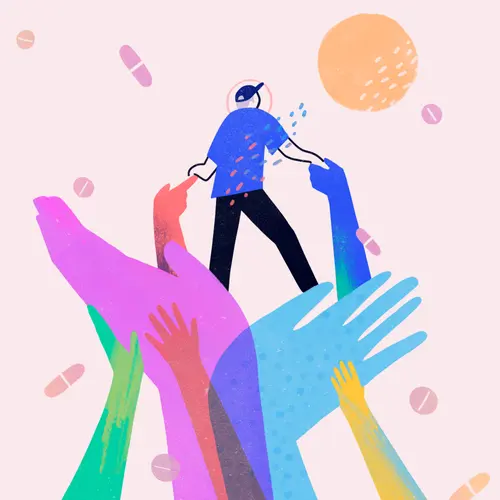The first reports of strange illnesses started popping up in New York and California in 1981. Healthy young gay men were sickened with Kaposi’s sarcoma, a cancer usually found in males who were much older. Others were coming down with a rare type of pneumonia.
A year later, the mysterious disease had a name: acquired immune deficiency syndrome, or AIDS. It destroyed the immune system and left the body open to all kinds of infections.
In 1983, scientists discovered the virus that causes AIDS. They later named it human immunodeficiency virus (HIV). The race was on for a treatment to stop this deadly disease.
Tough Target
HIV turned out to be hard to kill. For one thing, it attacks immune cells called T helper cells that normally protect against invaders like HIV. If enough T cells get destroyed, it leaves your body defenseless against the virus and other “opportunistic” infections.
HIV is a retrovirus, and it differs from viruses like the ones that cause colds and flu. A retrovirus is more efficient at tricking host cells in your body to make multiple copies of itself and causing lifelong infection.
By 1987, HIV had infected 32,000 people in the U.S. alone. More than half of them died.
Breakthrough HIV Drug
Researchers discovered that a failed cancer drug from the 1960s, zidovudine, stopped HIV from multiplying and helped people with AIDS live longer. Also called azidothymidine (AZT), the medication became available in 1987. Sold under the brand name Retrovir, AZT works by blocking proteins called enzymes that the virus needs to replicate itself.
The FDA approved AZT in less than 4 months, fast-tracking a process that usually takes many years. It treats HIV, but it isn’t a cure.
AZT had drawbacks. For one thing, it didn't work very well on its own. And it caused side effects like liver problems and low blood cell counts that could be deadly. AZT also at the time was the most expensive prescription drug in history, with a one-year price tag of $16,500 in today’s dollars.
Over the next several years, the FDA approved several other drugs that worked similarly to AZT. They belonged to a drug class called nucleoside reverse transcriptase inhibitors (NRTIs).
New Class of Antiretrovirals
By the early 1990s, HIV was the No. 1 cause of death among Americans ages 25 to 44. A big problem with a single-drug treatment like AZT is that viruses learn to change, or mutate, so the drugs over time stop working.
In 1995, the FDA approved saquinavir, the first in a different anti-HIV (antiretroviral) drug class called protease inhibitors. Like NRTIs, protease inhibitors stop the virus from copying itself, but at a different stage during the infection.
A year later came yet another class of antiretrovirals, called non-nucleoside reverse transcriptase inhibitor (NNRTI), including nevirapine (Viramune). Similar to AZT, NNRTIs shut down HIV by targeting the enzymes it needs to multiply.
These drugs paved the way to a new era of combination therapy for HIV/AIDS. Doctors began prescribing saquinavir plus AZT or other antiretrovirals. This combination therapy was dubbed highly active antiretroviral therapy (HAART). That approach became the new standard of care for HIV in 1996. HAART greatly lengthened the life span of people with AIDS.
Combination Pills
HAART required taking many pills every day. The multiple doses and the drugs’ side effects drove many people to quit their HIV therapy. Then in 1997, the FDA approved a pill called Combivir that contained two anti-HIV drugs and was easier to take.
Nearly 2 decades after the emergence of HIV and AIDS, a dozen antiretroviral drugs were on the market.
PrEP
Another leap in HIV treatment came in 2010. A study showed that taking a daily dose of antiretrovirals not only helped those who were HIV-positive, but also could protect healthy people from becoming infected.
In 2012, the FDA approved the drug Truvada once a day for pre-exposure prophylaxis, or PrEP. In 2021, the PrEP extended-release injectable cabotegravir suspension (Apretude) gained aFDA approval. It is given first as two injections administered one month apart, and then every two months thereafter. When you take PrEP according to guidelines, it can lower your risk of catching HIV to almost zero.
The United States Preventive Services Task Force now recommends that anyone who’s at risk for HIV infection take PrEP. That includes men who have sex with men, straight people who have unprotected risky sex, and those who inject drugs.
HIV Treatment Today
New HIV drug classes have come out in recent years. In 2007, the FDA approved the first integrase inhibitor, raltegravir (Isentress). This type of drug offers a different way to shortcut HIV from making copies of itself.
Today, more than 30 HIV medications are available. Many people are able to control their HIV with just one pill a day. Early treatment with antiretrovirals can prevent HIV-positive people from getting AIDS and the diseases it causes, like cancer. HIV drugs also stop people who have the virus from passing it to their partner during sex. We still don’t have a cure for AIDS. But with the right treatment, people who are HIV positive can live a normal life span.

